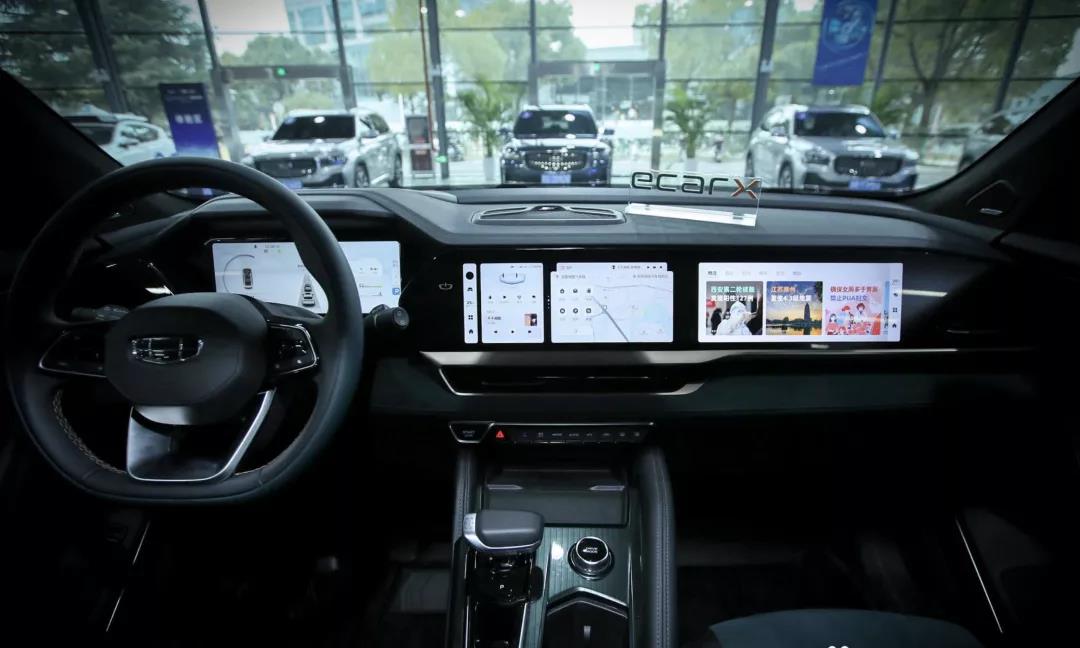Galaxy OS, the vehicle system carried by Xingyue L, is developed by its technology company Yikatong, which integrates the navigation and small voice of Baidu Apollo. It was officially launched in July 2021, equipped with Qualcomm Snapdragon 8155 chip and three screens.

Since its release, Galaxy OS has been upgraded twice. In the latest version 1.2, a lot of simplified upgrades have been made, and AutoLab has the following highlights to share after the experience.
Lightweight application of turning machine
Our mobile phone applications have also developed towards lightweight, and WeChat applets and Alipay applets have been able to replace most APP applications. In addition, in the latest system versions of Huawei and Apple, card-type fast APPlications have been added, so that the functions in the APP can be used conveniently without opening the APP, which saves the process of opening the app.
Xingyue L’s car machine update has also made a light APPlication of the APP, such as Bilibili of the co-pilot entertainment screen. You can see the recommended video content on the homepage of the screen without opening the app.

In addition, temperature control, music switching, and common map functions can be easily completed without opening the application. For example, the temperature can be adjusted by holding down the temperature number by hand and sliding up and down, which is more convenient than the physical knob. In addition, like the shortcut bar of mobile phone, Galaxy OS can open the shortcut button of vehicle control by pulling it from top to bottom, and can also add and subtract functions that can be operated quickly.

Since the Star Yue L central control is a widescreen, the Galaxy OS1.2 version is adapted to the widescreen homepage card, and the owner can directly slide up and down the homepage and choose to display four applications: music, map, WeChat applet and weather. Moreover, compared with the hidden sliding cards of many car companies, the cards of Galaxy OS 1.2 can guide the car owners to use correctly on the UI, which is more convenient and has lower learning cost.
The cockpit experience enters the scene
"Scene" is the most frequently mentioned word in the field of autonomous driving, and now the intelligent cockpit has begun to split the scene. In the Galaxy OS 1.2 version, the thinking of "scene" has also been added.

For example, when the main driver gets on the bus, the central control panel will pop up a shortcut bar for car control for about 5 seconds. In the shortcut bar, it can be used to adjust the seat and open the trunk, which is very convenient. When we experience other smart cars, we need to operate 2 to 3 steps on the screen every time we get on the bus to find the corresponding car control shortcut bar. This function of Galaxy OS is very practical and has a good impression of MAX.
In addition, there are many scenes on the central control screen and the passenger screen, which can be activated by touch screen click or voice control. For example, there is a car wash mode on the central control panel, which automatically closes the window skylight and retracts the rearview mirror after use. The nap mode is common to everyone. You can put down the seat with one button, turn on the ventilation and set an alarm clock.

There are also unusual scenes, such as the Goddess mode. After being enabled, the passenger seat will move backwards, and the seat will move forward after closing the door. The passenger screen will show a pink dynamic effect, and at the same time, a small voice will say: Welcome to the fairy, pick up hot chicks’s skills are full.
For the co-pilot screen, there will be a movie viewing mode. The co-pilot has an independent Bluetooth module, which can connect Bluetooth headsets and enjoy the independent sound source of the co-pilot screen without interfering with the driving of the main driver.

In addition, there is a co-pilot exclusive wallpaper, which can be used by users in need to declare sovereignty.
For the driver, the car WeChat has also been upgraded. When there is no one in the car, the message will be played directly. When there are other people in the car, the message from which friend will be displayed on the central control screen. Only when the owner presses the corresponding button will WeChat broadcast.

Thanks to the powerful computing power of Qualcomm 8155 chip, the co-pilot screen, the central control screen and the instrument screen can also be linked. Through three-finger sliding, the navigation map of the central control screen can be dragged to the instrument screen, and music and movies can be dragged to the co-pilot screen. The co-pilot screen can also query the map and send it to the central control screen for use.
The experience of Galaxy OS made my eyes shine. Personally, I think the user experience is better than that of most new car brands, and it is also better than the Baidu turnkey solution used by some brands before.
Behind this is the advantage of the tripartite joint model of car companies+technology companies+Baidu. Yikatong has assumed the role of product manager, collecting feedback from the daily use of tens of thousands of users, and then integrating Baidu’s technical solutions to polish the functions better.